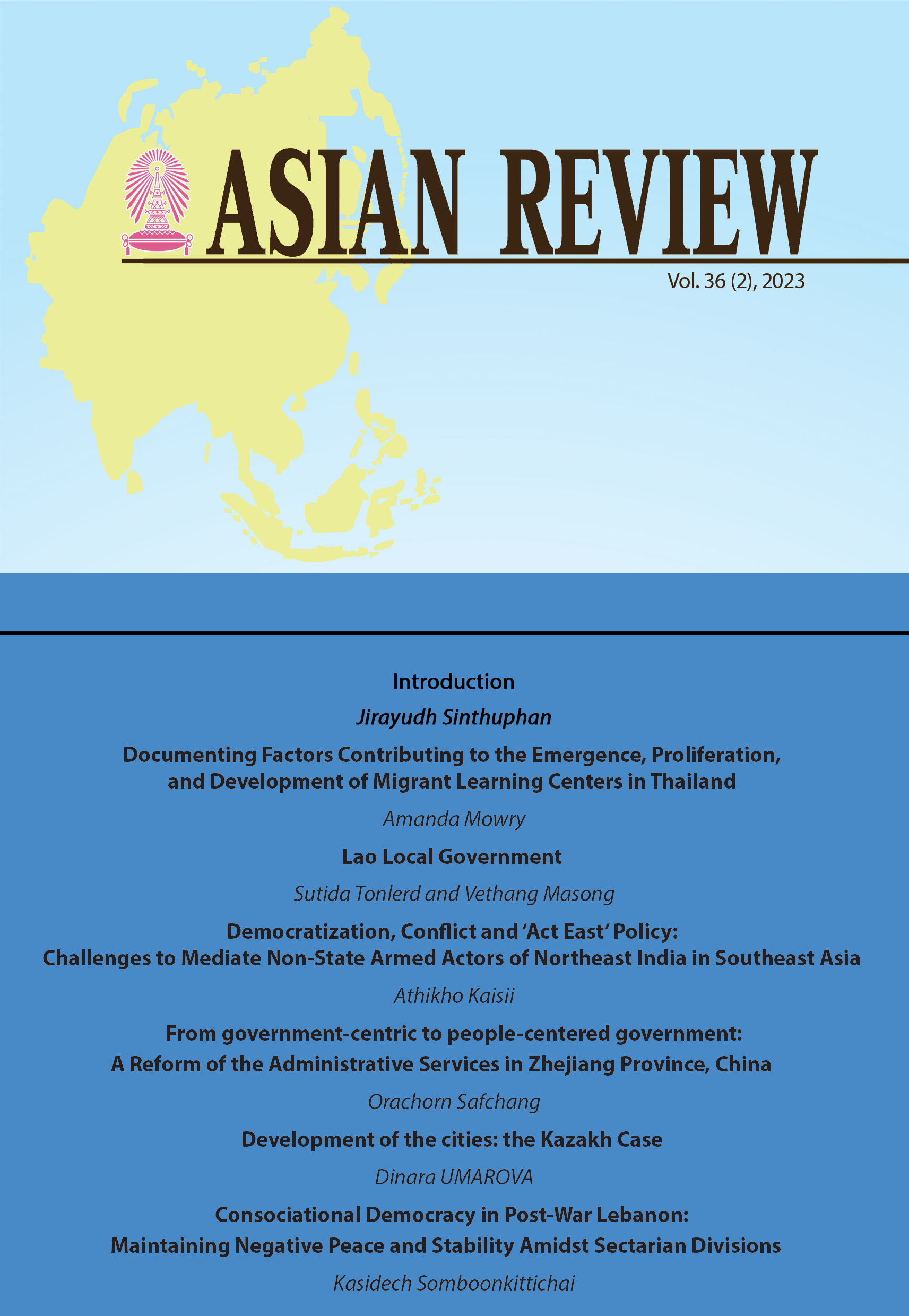The Development of The Cities: The Kazakh Case.
DOI:
https://doi.org/10.14456/arv.2023.9Keywords:
Kasakhstan, Urbanization, Competitiveness, Economic Growth, DevelopmentAbstract
The article is devoted to the development of Kazakh capital city Astana. The methodology of the research provides literature review on issues of urbanization and economic growth, comparative study, use of empirical and descriptive methods, and based on official statistics and statistical methods. The research confirms that status of the city and capital status of Astana ensure its competitiveness at the national level and in comparison with some leading regional Kazakh cities such as Almaty, Shymkent and Aktobe. The main indicators of the socio-economic situation in Astana are comparatively better. In particular, the capital city has relatively low rates of poverty and unemployment. Moreover, in Astana indicators of average life expectancy, average monthly wages and gross regional product per capita are higher. Also, considering dynamic growth of the population the article emphasizes the need to develop rural areas of the Astana agglomeration in order to provide the capital city with the basic foodstuff and construction materials.
References
Alwehab, Abdelwehab .2018. “Planning and Design Attributes of Preplanned Postmodern Capital Cities: A Comparative Study.” Urban Planning Iraq. 208-224. DOI 10.18502/keg.v3i4.2170;
Abilov, A.Z., Kusainova, G.K., Makhrova, A.G. 2017. “SOCIOLOGICAL STUDIES FOR THE ANALYSIS OF FORMATION OF THE METROPOLITAN AGGLOMERATIONS IN KAZAKHSTAN (CASE STUDY OF THE ASTANA CITY).” Vestnik Moskovskogo universiteta, Seriya 5, Geografiya, 4, 75-83.
ASHIQ-UR-RAHMAN, MD. 2012. “Housing the Urban Poor in Bangladesh: A Study of Housing Conditions, Policies and Organizations.” Heriot-Watt University . https://www.ros.hw.ac.uk/handle/10399/2600;
Boussauw, K., Van Meeteren, M., Sansen, J., Meijers, E., Storme, T., Louw, E., Derudder, B. & Witlox, F. 2018. “Planning for agglomeration economies in a polycentric region: Envisioning an efficient metropolitan core area in Flanders.” European Journal of Spatial Development. 69(1-26). DOI:http://doi.org/10.30689/EJSD2018:69.1650-9544;
Duranton, G. 2015. Growing Through Cities in Developing Countries.World Bank Research Observer. 30 (1) : 39-73. http://dx.doi.org/10.1093/wbro/lku006;
Glaeser, Edward L. 2010. Agglomeration Economics,376. University of Chicago Press.
Ghani, Ejaz, Arti Grover Goswami, Kerr, William R. 2016. “Spatial Development and Agglomeration Economies in Services. Lessons from India.” Policy Research Working Paper 7741, June. DOI:10.1596/1813-9450-7741
Kamal-Chaoui, Lamia, Leman, E., Zhang Rufei .2009. “Urban Trends and Policy in China.” OECD Regional Development Working Papers 2009/1(69). DOI:10.1787/225205036417;
Koshanov, A.K. 2019. “Urbanization and Social problems of territorial development (in Russian).” Obchestvo i economika. 2(64-82). DOI: 10.31857/S020736760004136-8;
Konovalova, J.A. 2020. “Regionalization of innovations: modern trends (in Russian).” Vestnik MIRBIS, №4 (24):24-33. DOI:10.25634/MIRBIS.2020.4.
Kuricheva, E.K., Kurichev, N.K. 2018. “Mechanisms of extensive and intensive development of the Moscow agglomeration at the macro and micro levels (in Russian).” Problemy razvitiya territorii (in Russian). 3(95):90-106. DOI: 10.15838/ptd.2018.3.95;
Manaeva, I.V. 2021. “Territorial and sectoral development of urban system of the region: assessment methodology (in Russian).” Problemy razvitiya territorii (in Russian). 25 (5): 21–36. DOI: 10.15838/ptd.2021.5.115.2;
Nicolaisen, Morten Skou, Olesen, M. and Olesen, K. 2017. “Vision vs. Evaluation – Case Studies of Light Rail Planning in Denmark The European Journal of Spatial Development. 65: 1-26.https://nordregio.org/publications/vision-vs-evaluation-case-studies-of-light-rail-planning-in-denmark/
Nurlanova, N.K. 2016. “The cities as the growth points of economic space of Kazakhstan: Trends and prospects of development (in Russian).” Problemy razvitiya territorii (in Russian). 5 (85): 201-216
Nallari, Raj, Griffith, B. and Shahid Yusuf .2012. Geography of Growth Spatial Economics and Competitiveness. http://hdl.handle.net/10986/6020 (Posted: April 20, 2012);
Quigley, John M. 1998. “Urban Diversity and Economic Growth.” Journal of Economic Perspectives. 12 (2) : 127–138. DOI: 10.1257/jep.12.2.127
OECD .2017. OECD Urban Policy Review: Kazakhstan (English version),232 .Paris : OECD Publishing.https://doi.org/10.1787/9789264268852-en
OECD .2020. OECD REGIONS AND CITIES AT A GLANCE 2020. https://www.oecd-ilibrary.org/;
Sanchez-Serra, Daniel .2016. “Functional Urban Areas in Colombia.” OECD Regional Development Working Papers 2016/08. https://dx.doi.org/10.1787/5jln4pn1zqq5-en
Tjurin, Gleb, Tjurin, Vladimir 2018. How to growth our villages. Local economy in Russia and in the world (in Russian),308. St. Petersburg: Publishing project «Zhivaya provinciya».
Tibekov, Bolat L., et al. 2010. Labor Migration Challenges in Economic Planning: A Case Study of Astana. Advances in Competitiveness Research. 18(1) : 129-39.
Downloads
Published
How to Cite
Issue
Section
License
Copyright (c) 2024 Instiute of Asian Studies, Chulalongkorn University

This work is licensed under a Creative Commons Attribution-NonCommercial-NoDerivatives 4.0 International License.
Published articles are under the copyright of the Instiute of Asian Studies, Chulalongkorn University. Partially or totally publication of an article elsewhere is possible only after the consent from the editors.







